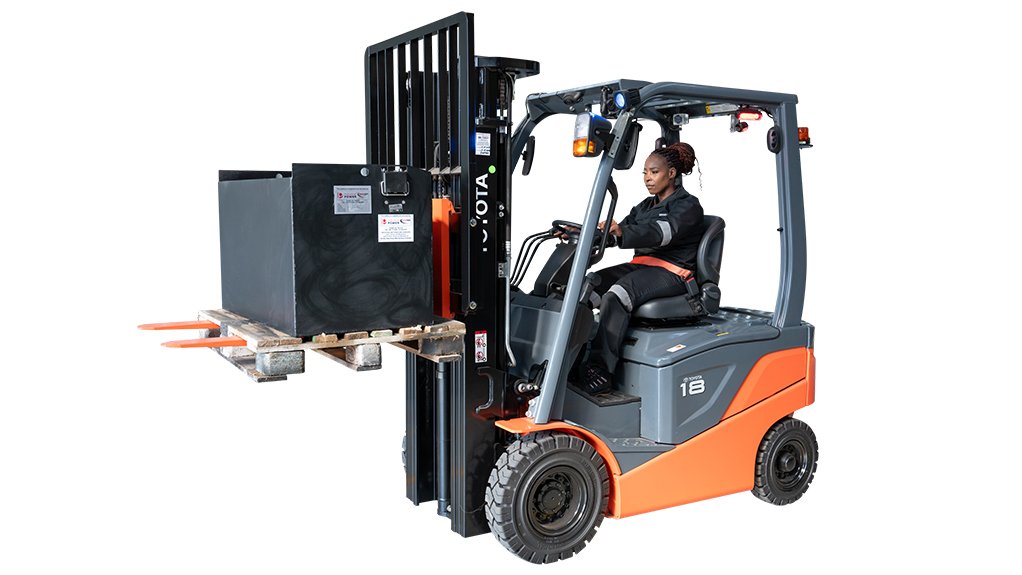Battery-operated forklifts offer sustainability in warehousing


SUSTAINABLE LIFTING Using-battery powered forklifts instead of liquified petroleum gas units helps decrease a warehouse's emissions
As the world looks towards a more sustainable future, more businesses are being guided by regulations to reduce carbon emissions.
For example, in applications such as food storage and handling, businesses are recommended to use battery-powered units instead of liquified petroleum gas (LPG) units, in line with the Global Food Safety Initiative’s suggestions on avoiding contamination from forklifts in produce-packing and cooling operations.
Further, earlier this year, Masslift Africa national sales manager Hugh Golden told Engineering News that looming changes in local legislation would increase the demand for zero-emission forklifts, stating that, “legislation will inevitably move towards minimising the use of diesel forklifts around food products. We are also seeing several clients moving away from diesel- or LPG-powered forklifts, owing to the emissions and the costs associated”.
Internal combustion engine (ICE) forklifts expel emissions, while lead-acid batteries emit gases when charged, says materials handling equipment supplier Toyota Material Handling counterbalance equipment national product manager Brent Light.
With the use of lithium-ion batteries, however, emissions are eliminated, resulting in a cleaner and more environment-conscious working environment.
Over the past few years, Toyota Material Handling, a division of forklifts and related solutions’ distributor CFAO Equipment SA, has seen a steady increase in demand for battery-operated equipment.
Typical market growth has ranged between 2% and 3%, mostly owing to clients shifting from traditional ICE forklifts to battery-operated forklifts.
Last year, however, growth was measured at 5%, a significant increase that exceeded the division’s expectations, notes Light.
This increase was driven predominantly by the adoption of lithium-ion battery-operated forklifts, which are now responsible for around 80% of sales, compared with lead-acid battery forklifts.
“Battery technologies have come a long way in the past few years,” he adds, noting that where lead-acid battery technology might have held back the adoption of battery-operated forklifts – owing mainly to the rate of discharge and the maintenance required – lithium-ion is now propelling the market.
“This has been augmented by business cycles, such as the large-scale fleet replacements that occur every three to four years,” he says.
He points out that the adoption of battery-operated forklifts is being driven by sustainability, greater efficiencies and return on investment (ROI), as well as driver comfort.
Efficiencies, ROI
Light stresses that ICE forklifts are more expensive to run.
He explains that fuel for an ICE truck costs between R20/ℓ and R25/ℓ, whereas electricity for battery-operated equipment costs just R1.50/kW.
Further, the efficiency of an electric machine, on a per-hour basis, makes it more economical to run, particularly considering the virtual 100% energy efficiency of a lithium-ion battery.
“Energy consumption, and the cost of that energy, is less for an electric forklift compared with an ICE forklift,” says Light.
Therefore, in all applications, even though the upfront costs may be high, lithium-ion units will eventually result in a cost saving.
This saving can be delayed in some “very low use applications”, so the switch to lithium-ion powered units might not always be justifiable to the business.
“However, with a high- or medium-intensity operation, ROI will be realised fairly quickly – within 24 months to 36 months you will see significant savings,” says Light.
ROI is also realised through the cost of maintenance, which is a lot less on an electric forklift, as it has fewer moving components, so less can go wrong, and tyre wear is also reduced because it is almost impossible to create wheel spin.
Driver Comfort
Light adds an electric forklift has zero vibration, and its noise levels are less than that of an ICE forklift, making it a lot more comfortable to operate.
“While we are focused on growing the electric market, most businesses still use ICE forklifts, and will do so for some time,” he says.
Although the move towards electric forklifts is happening slowly, as battery-powered machinery becomes more capable in handling difficult environments, adoption should speed up.
It is important to consider that dif- ferent applications require different technologies.
For example, in a brickyard or concrete facility, using electric forklifts might be a drawback, as they do not have the extra power provided by ICE forklifts and, since the work area is mainly outdoors, the emissions requirements will most likely not be as stringent.
There are also certain applications where lead-acid battery technology is still viable, and lithium-ion potentially less so.
However, the company has found clients moving to lithium-ion because of the maintenance benefit, even when they do not require the longer lifespan or the longer operating time of the lithium-ion battery.
With lithium-ion batteries clients do not need to worry about topping up water levels, and if clients need to short-charge, it can be done without any impact on the battery.
Having a variety of forklifts available will continue to appeal to clients, and their choice of machine will depend on what it will be used for.
“It is important that clients consider all options and choose the most suitable machine for the application,” concludes Light.
Article Enquiry
Email Article
Save Article
Feedback
To advertise email advertising@creamermedia.co.za or click here
Comments
Press Office
Announcements
What's On
Subscribe to improve your user experience...
Option 1 (equivalent of R125 a month):
Receive a weekly copy of Creamer Media's Engineering News & Mining Weekly magazine
(print copy for those in South Africa and e-magazine for those outside of South Africa)
Receive daily email newsletters
Access to full search results
Access archive of magazine back copies
Access to Projects in Progress
Access to ONE Research Report of your choice in PDF format
Option 2 (equivalent of R375 a month):
All benefits from Option 1
PLUS
Access to Creamer Media's Research Channel Africa for ALL Research Reports, in PDF format, on various industrial and mining sectors
including Electricity; Water; Energy Transition; Hydrogen; Roads, Rail and Ports; Coal; Gold; Platinum; Battery Metals; etc.
Already a subscriber?
Forgotten your password?
Receive weekly copy of Creamer Media's Engineering News & Mining Weekly magazine (print copy for those in South Africa and e-magazine for those outside of South Africa)
➕
Recieve daily email newsletters
➕
Access to full search results
➕
Access archive of magazine back copies
➕
Access to Projects in Progress
➕
Access to ONE Research Report of your choice in PDF format
RESEARCH CHANNEL AFRICA
R4500 (equivalent of R375 a month)
SUBSCRIBEAll benefits from Option 1
➕
Access to Creamer Media's Research Channel Africa for ALL Research Reports on various industrial and mining sectors, in PDF format, including on:
Electricity
➕
Water
➕
Energy Transition
➕
Hydrogen
➕
Roads, Rail and Ports
➕
Coal
➕
Gold
➕
Platinum
➕
Battery Metals
➕
etc.
Receive all benefits from Option 1 or Option 2 delivered to numerous people at your company
➕
Multiple User names and Passwords for simultaneous log-ins
➕
Intranet integration access to all in your organisation

















